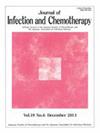青蒿素三联疗法(TACT):在小鼠疟疾模型中,双氢青蒿素-哌喹加氯喹对具有不同药物敏感性的伯格希氏疟原虫 ANKA 株的疗效。
IF 1.9
4区 医学
Q3 INFECTIOUS DISEASES
引用次数: 0
摘要
背景:在东非恶性疟原虫患者分离株中检测到明显的青蒿素抗药性标记,这威胁到青蒿素类复方疗法(ACTs)作为撒哈拉以南非洲疟疾一线治疗药物的疗效。有人认为,将以前使用的抗疟药重新定位为青蒿素综合疗法的补充疗法是缓解这一威胁的可行方案。本研究在小鼠模型中评估了氯喹(CQ)作为双氢青蒿素/哌喹(DHA/PQ)的辅助伙伴治疗疟疾的潜在益处:方法:在不同的实验中评估了 DHA/PQ/CQ 和 DHA/PQ 组合对两种对氯喹敏感程度不同的 ANKA 伯格氏疟原虫菌株(MRA 311 和 671)的疗效比较。在体内对寄生虫活性进行了评估,包括寄生虫抑制时间、寄生虫清除时间、复发时间和寄生虫减少率。在整个研究期间还监测了平均存活时间:结果:在两种寄生虫品系中,药物治疗组(单用 CQ、DHA/PQ 和 DHA/PQ/CQ)在第 4 天的化疗抑制率均为 99.99%。在治愈试验中,DHA/PQ/CQ 和 DHQ/PQ 治疗之间存在显著差异,突出表现为寄生虫清除时间缩短(4.75±0.3 天 Vs 5.5±0.3 天,PC 结论:在双氢青蒿素-哌喹中添加氯喹可能有利于治疗疟疾,特别是在疟原虫对氯喹敏感的地区。本文章由计算机程序翻译,如有差异,请以英文原文为准。
Triple artemisinin-based combination therapy (TACT): Efficacy of dihydroartemisinin-piperaquine plus chloroquine against Plasmodium berghei ANKA strains with different drug sensitivities in a murine malaria model
Background
Evident detection of artemisinin resistance markers in patient isolates of Plasmodium falciparum from East Africa threatens the efficacy of artemisinin-based combination therapies (ACTs) as first-line treatment of malaria in sub-Saharan Africa. Repositioning previously used antimalarials as complementary addition to ACTs has been suggested as a viable option to mitigating this threat. This study evaluated the potential benefit of chloroquine (CQ) as a complementary partner to dihydroartemisinin/piperaquine (DHA/PQ) in the treatment of malaria in a mice model.
Methods
The comparative efficacy of the combination of DHA/PQ/CQ and DHA/PQ against two strains of Plasmodium berghei ANKA (MRA 311 and 671) with different levels of sensitivities to chloroquine was evaluated in separate experiments. Parasitological activities including; parasite suppression time, parasite clearance time, recrudescence time, and parasite reduction ratio were evaluated in vivo. The mean survival time was also monitored throughout the duration of the study.
Results
In both parasite lines, 99.99 % chemo-suppression was observed on day 4 in the drug treatment groups (CQ alone, DHA/PQ and DHA/PQ/CQ). In the curative test, there were significant differences between DHA/PQ/CQ and DHQ/PQ treatment, highlighted by reduced parasite clearance time (4.75 ± 0.3 Vs 5.5 ± 0.3 days, P < 0.05), significantly delayed recrudescence time (28.5 ± 1.04 Vs 13.3 ± 0.48 days, P < 0.01), a 1.5-fold change in parasite reduction ratio, and a prolonged mean survival time (34.5 ± 1.04 Vs 26.7 ± 0.48 days, P < 0.05).
Conclusion
The addition of chloroquine to dihydroartemisinin-piperaquine may be beneficial in the treatment of malaria, especially in areas where malaria parasite sensitivity to chloroquine is predominant.
求助全文
通过发布文献求助,成功后即可免费获取论文全文。
去求助
来源期刊

Journal of Infection and Chemotherapy
INFECTIOUS DISEASES-PHARMACOLOGY & PHARMACY
CiteScore
4.10
自引率
4.50%
发文量
303
审稿时长
47 days
期刊介绍:
The Journal of Infection and Chemotherapy (JIC) — official journal of the Japanese Society of Chemotherapy and The Japanese Association for Infectious Diseases — welcomes original papers, laboratory or clinical, as well as case reports, notes, committee reports, surveillance and guidelines from all parts of the world on all aspects of chemotherapy, covering the pathogenesis, diagnosis, treatment, and control of infection, including treatment with anticancer drugs. Experimental studies on animal models and pharmacokinetics, and reports on epidemiology and clinical trials are particularly welcome.
 求助内容:
求助内容: 应助结果提醒方式:
应助结果提醒方式:


